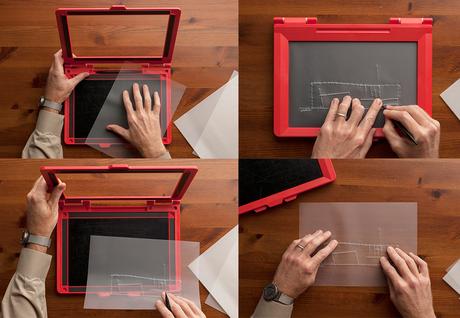
Chris Downey says that it was terrifying to wake up blind after eye surgery, but he never considered giving up architecture. Today he consults on projects like the Independent Living Resource Center of San Francisco, providing insight into accessiblity issues. Tools like the inTACT Sketchpad help him to draw and read plans.
Image courtesy of Don Fogg.When it comes to making the built environment easier to navigate, how can technology help?
The most promising interior wayfnding [tool], in my opinion, is beacon technology, which uses low-energy Bluetooth [signals] to send location information and notifcations to a smartphone. The promise comes through its economy, the ease of incorporation within built space, and its indoormapping potential for the general public. The device is about the size of a watch face, has a four-year power supply, and has no infrastructure to be integrated into the architecture. The installation at Terminal 2 of the San Francisco International Airport is the result of a collaboration between the San Francisco mayor’s offce, the technology company indoors, and the San Francisco LightHouse for the Blind and Visually Impaired. I’ve successfully used it, with no training or orientation, to locate my gate, the men’s room, a bite to eat, coffee, and even electrical outlets. Finding an outlet in an airport is a real challenge—try it blind!
What are some other new technologies that show promise?
There’s one on the cusp of development that could revolutionize how I work. With embossing printers and techniques for tactile drawing, architectural drawings can be accessed through touch. But I’ve not found a way for someone without sight to input graphic information into a computer. I’m now collaborating with the developers of the inTACT Sketchpad, which enables someone to draw on a tablet and feel the raised line that forms as the stylus passes over the surface. The graphic information can then be uploaded to the computer through a USB connection.
Tell us about your collaboration with the engineers at Arup on the acoustics for the LightHouse for the Blind and Visually Impaired’s new headquarters in San Francisco.
Architects focus a lot on the visual aspects of architecture largely because it can be drawn. It’s very hard to draw sound. The acoustic modeling technology developed and used by Arup’s acoustic engineers in their SoundLab is important for the blind and visually impaired, who listen to space to recognize where they are and what they’re looking for. Acoustic modeling of digital space during the design phase allows architects to make qualitative decisions to improve acoustic performance, which is promising for any space where acoustics play a signifcant role.
Are there dangers to viewing technology as a magic wand?
Many people view GPS and similar emerging interior-wayfnding technologies as a way to “solve the blind wayfnding challenge.” But no handheld technology can safely guide a blind traveler who isn’t tech-savvy or suffciently independently mobile—and it’s unpleasant to imagine a future in constant reliance on technology for guidance. There needs to be enough multisensory information, in the form of environmental landmarks and cues, that can be related spatially back to the directional information provided through that wayfnding technology. Architects still need to be better multisensory placemakers to design and create effective environments for the blind and visually impaired—which, in turn, will make those spaces more effective and enjoyable for all.
